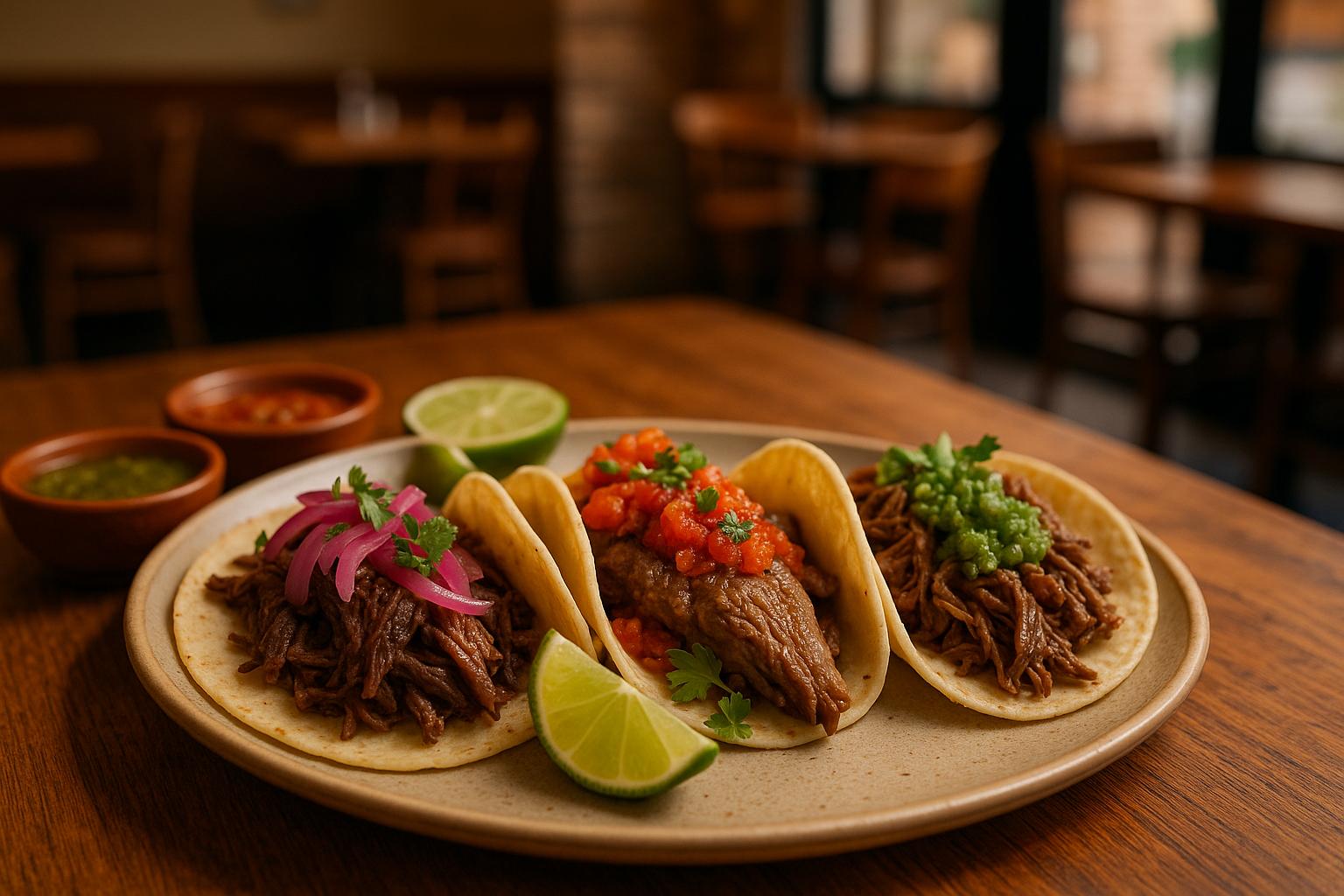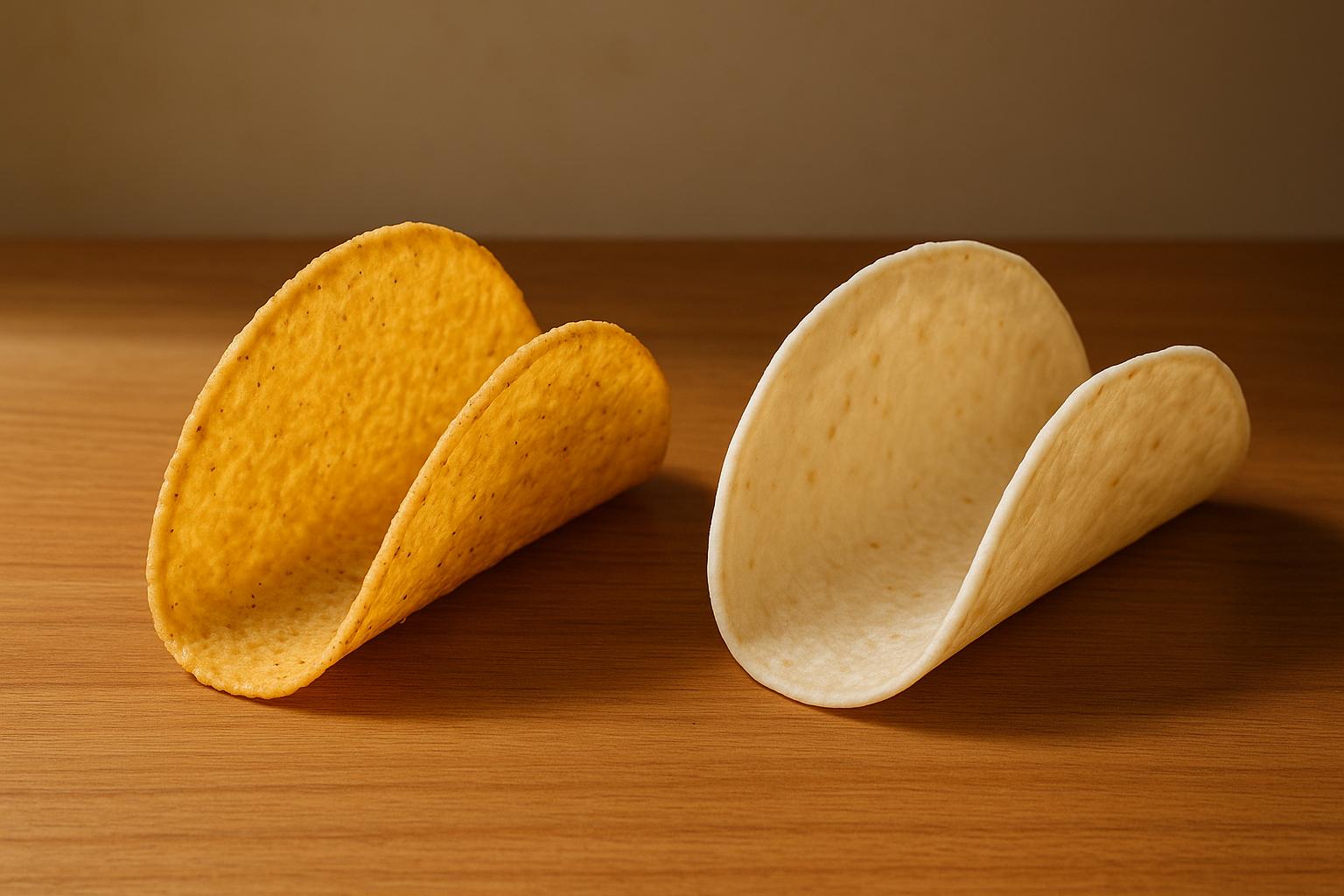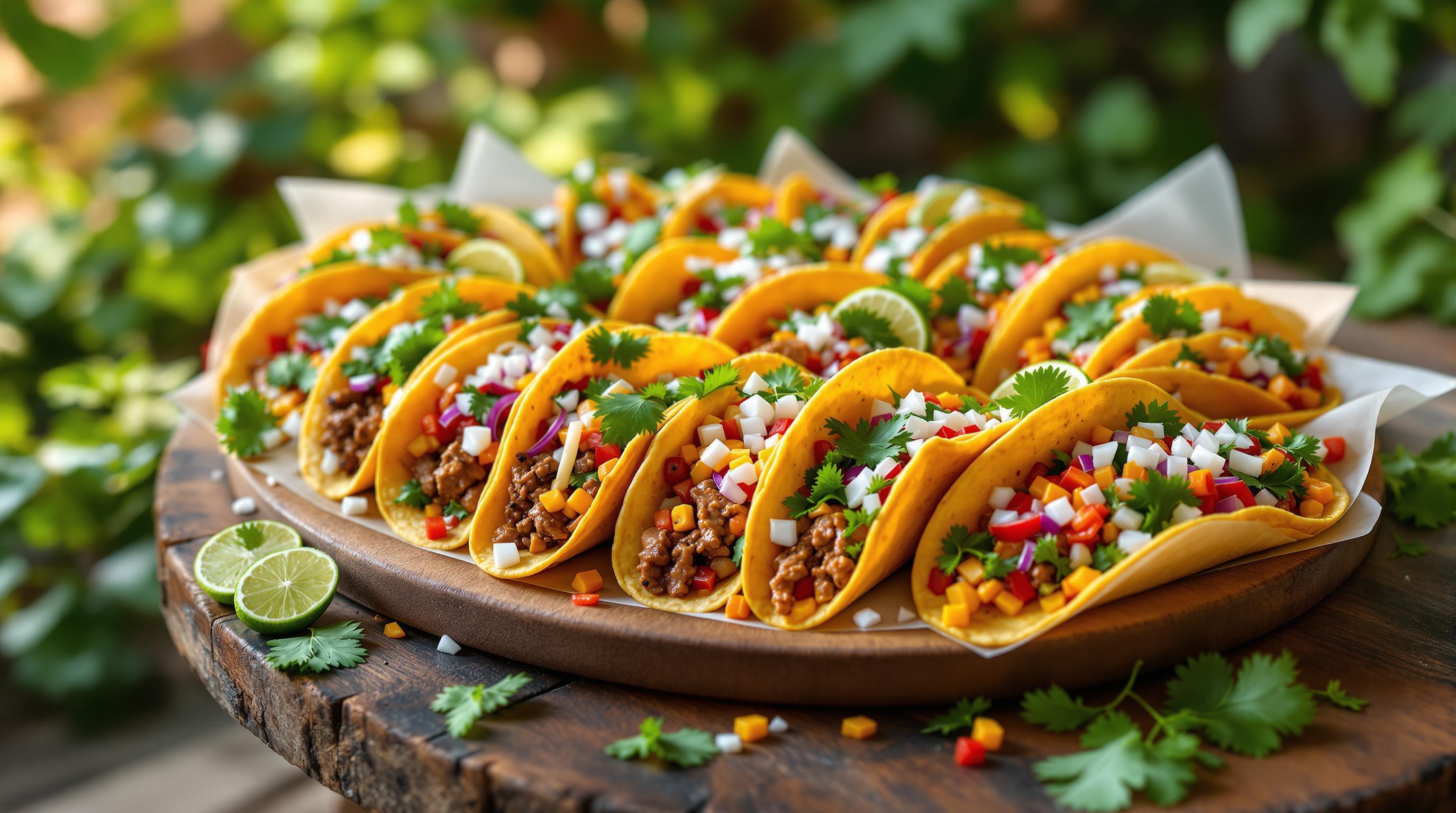Want to make your taco sauces richer and more flavorful? Sauce reduction is the key. It’s a simple method of simmering sauces to intensify flavors and thicken the consistency, making them perfect for tacos. Here’s what you need to know:
- What is Sauce Reduction? Simmer sauces to evaporate water, concentrate flavors, and create a smooth texture.
- Why It Works: Reduction enhances taste, balances ingredients, and ensures the sauce clings to taco fillings.
- How to Do It: Use a wide pan, control heat, stir often, and stop when the sauce coats the back of a spoon.
- Tools You’ll Need: Tri-ply pans, timers, thermometers, and blenders for precise results.
Quick Tips:
- Use medium heat for faster reduction; low heat for delicate flavors.
- Blend and strain for a smooth finish.
- Adjust thickness with stock or cream if needed.
Start reducing your sauces today for bold, taco-ready flavors!
What is a Reduction? How to Reduce a Sauce
Sauce Reduction Methods
Master these techniques to achieve the perfect consistency for your taco sauce.
Basic Stovetop Method
Start by pouring your sauce ingredients into a wide pan and setting it over medium-high heat. Stir consistently to prevent sticking. Once you see large bubbles forming, lower the heat to avoid boiling over [5]. This method naturally thickens the sauce without needing extra thickeners.
A good sign that your sauce is properly reduced is when it coats the back of a spoon. Keep in mind, sauces tend to thicken further as they cool [5]. For tomato-based taco sauces, this method is excellent for concentrating flavors while achieving just the right texture. If your sauce requires a gentler flavor development, opt for a slower, low-heat reduction.
Low-Heat Reduction
For more complex taco sauces, low-heat reduction offers better results. Using a wide pan speeds up the process while maintaining the gentle heat needed to preserve delicate flavors [3][4]. This approach is ideal when working with sensitive ingredients or aiming for richer flavor profiles.
Here are some tips to keep in mind:
- Watch small batches closely and season with salt only after reducing to avoid over-salting [4][7].
- If your sauce includes alcohol, reduce it separately before mixing it with the other ingredients [1].
"Too-high heat can cause the sauce to over-reduce and/or become bitter." - Bon Appétit [3]
Aim for a texture similar to thick maple syrup - dense enough to coat a spoon but still pourable [6]. This ensures the sauce clings to your taco fillings without feeling too heavy. After achieving the right consistency, blend the sauce for a polished finish.
Blending for Smooth Texture
To refine your sauce, use a variable-speed blender for precise control over the final texture [8]. Begin blending at a low speed, gradually increasing it while adding small amounts of liquid as needed to reach your desired consistency.
For an extra-smooth finish, strain the blended sauce through a fine-mesh strainer to remove any solids [2]. This step guarantees a silky texture that spreads evenly across your tacos.
| Blending Method | Best For | Tips |
|---|---|---|
| Standard Blender | Large batches | Add liquids gradually while blending |
| Bullet Blender | Small portions | Great for quick, smooth results |
| Immersion Blender | In-pot blending | Less effective for ultra-smooth textures |
Patience is key when blending. Add liquid incrementally to ensure you preserve the concentrated flavors developed during reduction [8]. This careful approach prevents thinning out your sauce while delivering a perfectly smooth and flavorful finish.
Required Kitchen Tools
Getting a perfectly reduced taco sauce isn't just about the recipe - it’s also about having the right tools. The proper equipment can make all the difference in achieving consistent, flavorful results. Let’s break down the essentials.
Choosing the Right Pan
The pan you use plays a huge role in the success of your sauce reduction. Tri-ply stainless steel pans with an aluminum core are a top choice because they distribute heat evenly and are built to last [12]. On the other hand, nonstick pans should be avoided - these prevent the formation of fond, the browned bits that add depth to your sauce [10].
For the best results, consider using a saucier pan. Its unique rounded edges and flared sides provide several advantages:
- Better evaporation for quicker reduction
- Easier stirring and whisking
- No sauce getting stuck in hard-to-reach corners [9]
| Pan Style | Best For | Features |
|---|---|---|
| Tri-ply Stainless Steel | Even heating, fond development | Quick temperature adjustments |
| Cast Iron | Heat retention, slow reduction | Great for long-simmering sauces |
| Saucier | Professional-style reduction | Rounded corners, flared sides |
Once you’ve chosen the right pan, maintaining precise temperature control becomes the next step.
Temperature Control Tools
Precision is key when reducing sauces, and a good timer and thermometer are your best friends in the kitchen. The ThermoWorks Extra Big and Loud Timer ($29) is a favorite for its clear display and loud alarms [15]. If you’re juggling multiple sauce batches, the YOOYIST 4-Channel Commercial Kitchen Timer ($36.99) is a lifesaver with its ability to track several timings at once [13].
"A timer and a thermometer are the most important tools in my kitchen. They tell me, when I may be distracted, that it is time to make a decision." - David Dixon, Cook [14]
Here are a few other must-haves to elevate your sauce reduction game:
- Wooden or silicone spoons: Gentle on your pan’s surface and perfect for stirring.
- Flat, sturdy whisks: Prevent sticking and help emulsify the sauce [11][16].
- Chinois (fine mesh sieve): Strains out solids for a smooth, professional finish [16].
- Immersion blender: Quickly adjusts the sauce’s texture without the hassle of transferring hot liquids [16].
With these tools in hand, you’ll be fully equipped to create taco sauces that are rich, smooth, and bursting with flavor.
sbb-itb-8621021
Taco Sauce Recipes
These recipes use reduction techniques to create bold, concentrated flavors and the perfect texture for taco sauces.
Red Chile and Tomato Sauce
Start by cleaning dried red chile pods with a damp paper towel, then remove the stems and seeds. This sauce combines the earthy heat of New Mexican red chiles with the smoothness of tomato sauce, creating a classic, well-rounded flavor.
| Ingredient | Amount | Notes |
|---|---|---|
| Dried Red Chile Pods | 8–10 pods | New Mexican variety |
| Tomato Sauce | 2 cups | Unseasoned |
| Garlic Cloves | 4–5 cloves | Minced |
| Ground Cumin | 1 tablespoon | Toast before adding |
"This recipe is very authentic", shares an Expat New Mexican reviewer. "I sometimes use roasted red bell peppers instead of tomato for my chili sauce, and people really love it." [17]
Next, let’s dive into a sauce with a hearty twist inspired by Chicago’s culinary flair.
Chicago-Style Beer Onion Sauce
To make this sauce, heat a heavy-bottomed skillet over medium heat and caramelize onions on medium-low until they turn golden and tender. Deglaze the pan with a low-bitter beer like dunkel or bock, making sure to scrape up the browned bits for extra depth. Let the mixture simmer until it thickens, and if it reduces too much, add a splash of water to adjust the consistency.
For something truly unique, try a sauce that combines spice with the richness of coffee.
Ancho Chile Coffee Sauce
This sauce blends the smoky, raisin-like flavor of ancho chiles with the boldness of coffee for a one-of-a-kind taco topping [18]. Start by removing the seeds from the ancho chiles to control the heat level. Then, mix in strong brewed coffee, unsweetened cocoa powder, and a touch of honey to balance the spiciness. Allow the sauce to simmer on low heat until it thickens and the flavors come together harmoniously.
Fixing Common Problems
Even with careful reduction techniques, occasional hiccups can occur, and quick fixes are essential to keep your sauce's flavor and texture on point.
Correcting Thick Sauces
If your sauce turns out too thick, you can easily adjust it without sacrificing flavor. For tomato-based sauces, gradually mix in stock or broth to thin it out while keeping the taste intact [22]. Cream-based sauces, on the other hand, can be adjusted with a splash of heavy cream, which not only balances the thickness but also enhances the overall texture.
| Sauce Type | Thinning Agent | Alternative |
|---|---|---|
| Tomato-based | Stock or broth | Tomato sauce |
| Cream-based | Heavy cream | Whole milk |
| Spicy sauce | Dairy products | Citrus juice |
If your sauce is too spicy, dairy products like cream or yogurt can help tone down the heat [23]. Alternatively, ingredients high in fat, such as nuts or nut butter, can work wonders by neutralizing the oils responsible for the spice.
Once you've tackled the consistency, it's time to address any potential flavor issues, like a metallic aftertaste.
Avoiding Metal Taste
A metallic flavor can sneak into your sauce due to acidic ingredients reacting with certain cookware or tannins from tomato skins and seeds. Here’s how to keep your sauce tasting fresh and pure:
- Cookware matters: Avoid using seasoned cast-iron pans for acidic recipes [21].
- Use quality ingredients: Opt for fresh tomatoes or premium canned varieties to reduce the risk of metallic flavors [19].
- Sauté smartly: Cook tomato paste for 3–5 minutes before adding liquids. This step helps mellow out any harsh, metallic undertones [19].
If you notice a metallic taste, a small pinch of baking soda can help neutralize the tannins - but go easy to avoid altering the flavor [19]. When using vinegar, stick to milder options like red wine, champagne, or apple cider vinegar, and dilute them with water before mixing them into your sauce [20]. Lastly, use wooden or plastic utensils instead of stainless steel to avoid introducing unwanted metallic notes while stirring [21].
Summary
Mastering taco sauce reduction is the secret to creating sauces that pack a punch of flavor for your tacos. By letting the liquid simmer gently and giving it a regular stir, you can transform simple ingredients into rich, concentrated sauces that add depth to every bite.
On average, reducing 2 cups of liquid will yield about 1 cup of sauce [6]. This process requires your attention - keep the simmer steady and stir often to avoid burning. You’ll know the sauce is ready when it coats the back of a spoon evenly, leaving a smooth layer. This perfect consistency not only intensifies the flavor but also ties your culinary efforts to the bold taco traditions of Chicago.
Reduction isn’t just about thickening; it’s about building layers of flavor. Chicago’s taco scene demonstrates this beautifully. Spots like La Chaparrita, with its authentic "comal con sombrero" technique, and Birrieria Zaragoza, known for recipes perfected over generations, show how reduced sauces can turn humble tacos into unforgettable dishes [24].
For dependable results, keep these stages in mind:
| Stage | Key Action | Why It Matters |
|---|---|---|
| During Reduction | Maintain a steady simmer | Prevents burning and ensures even flavor development |
| Mid-Process | Taste frequently | Lets you adjust seasoning as flavors intensify |
| Final Stage | Test consistency | Guarantees the sauce has the right thickness |
Whether you’re making a classic red chile sauce or experimenting with bold new flavors, mastering these reduction techniques will give you sauces that truly stand out. For more inspiration, check out Chicago Taco Spot and see how local taquerias are reshaping traditional sauce-making with their creative approaches.
FAQs
What mistakes should I avoid when reducing taco sauce, and how can I fix them?
When reducing taco sauce, there are a few common pitfalls to watch out for. Overcooking can lead to a burnt or bitter flavor, while adding too much liquid can leave you with a sauce that's far too runny. To steer clear of these issues, simmer the sauce over medium heat and give it regular stirs to prevent sticking or burning.
If your sauce ends up too thick, don’t panic! Just add a splash of water or broth to loosen it up until you hit the consistency you’re after. On the flip side, if it’s too thin, let it simmer uncovered to naturally evaporate the extra moisture. A quick fix for thickening is mixing a small amount of cornstarch with water and stirring it in - but go easy, as too much can mess with the texture.
The secret to success here? Patience. Allowing the sauce to reduce slowly ensures you’ll get that rich, flavorful consistency you’re craving.
What role do pans and kitchen tools play in reducing taco sauce?
When it comes to reducing taco sauce, having the right pan and kitchen tools can make all the difference. A saucepan with tall, straight sides is ideal. Its design helps control evaporation and ensures the heat spreads evenly, allowing the sauce to simmer gently without the risk of burning. This steady simmer is crucial for getting that perfect, thick consistency.
As for tools, a whisk or wooden spoon is a must-have. These tools help you stir the sauce smoothly, preventing it from sticking to the pan and ensuring a silky texture. By using the right equipment, you not only improve the flavor but also guarantee a beautifully reduced taco sauce every time.
Can I use these taco sauce reduction techniques for other sauces or cuisines? How would the process change?
When it comes to cooking, the same reduction techniques used for taco sauce can easily be applied to a variety of other sauces from different cuisines. The principle is straightforward: simmer the sauce to let water evaporate. This not only thickens the texture but also concentrates the flavors, making the sauce richer and more flavorful. It’s a simple trick that works for everything from pasta sauces to hearty gravies.
Of course, the specifics can vary depending on the cuisine. A French-style reduction might incorporate wine and cream for a velvety finish, while an Asian-inspired sauce could lean on soy sauce and ginger for bold, savory notes. The key is to tweak the ingredients and seasonings to complement the dish you're making. You can also experiment with aromatics or spices to add more depth. Just be sure to monitor the heat carefully - too high, and you risk burning or over-reducing the sauce!


